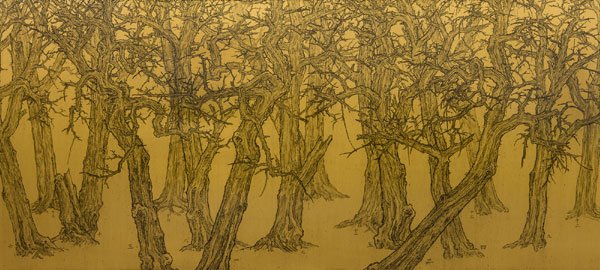Philosophy in China and in the West: Reflection on an Art Exhibition
![]()
Recently I visited 'A Chinese Journey: The Sigg Collection,' an exhibition in the Noordbrabants Museum in 's-Hertogenbosch, the Netherlands. Part of the collection of a Swiss collector of contemporary Chinese art was on display, before it is heading to a new to-be-opened museum M+ in Hong Kong, the new museum for visual culture in Hong Kong. Sigg travelled to China a lot for his work, and later as a diplomat, and noticed there was no place for Chinese art to be collected, so he started doing that himself, also helping the artists through his commissions.
Seeing philosophy through a new perspective
Several pieces stood out to me. But mostly this one, 'Forest' by Ni Youyu, and when I read the accompanying explanation, it didn't surprise me why I liked this so much.
It consists of two huge paintings, hung side by side, but here I will present them to you like this. The first one on the left:

The second one on the right:
The first one shows Chinese philosophy. Old, and all coming together, it is difficult to distinguish the one from the other. Every tree represents some philosopher, just like it does in the 'Western Philosophy' in the second painting, yet the way they present themselves and how they interact is very different.
It touched me a lot, seeing this like this, next to each other. It are huge paintings, with care and somehow very realistic although also abstract in a way. You can see in the detail on the right, how much care and effort went into each trunk. Yet it also shows one more aspect which maybe isn't very visible on the large image: how each tree has a date. I'm a philosopher myself, and as I went through all the trees, I recognised some of these dates. Heidegger, Nietzsche, Kant. It was weird, this symbolism combined with a very telling comparison.
The two forests of East and West are very different. Which one do you feel most at home in? Is there a way to feel at home, even. And what does it mean, when society and the structure of thought is reflected in the biological surrounding? Are we the way we are because of the type of trees that we see every day, the tall pine trees that truly are just like that, like Western philosophy, never meeting the other, trying to become the highest, taking away the sun for anything that would like to grow underneath.
Images by @nobyeni, except the image from the 'chinese' forst: source.

Wow. Interesting reflection. I thought this would be related to Huntington's "The clash of civilizations", but it turned out better.
Western culture is very complex, in my humble opinion. I see no traceable aboriginal roots, so I think this is the cause of the non-connaissance of the otherness. Of course, I'm presenting this very lightly (very unscholarly), but I think this lost connection to our ancestry creates the void I perceive in our culture. I say this because I'm familiar with South American indigenous folks and their cosmovisions. And I can see how it has permed into the cultures of the remaining nations. It's just my humble opinion.